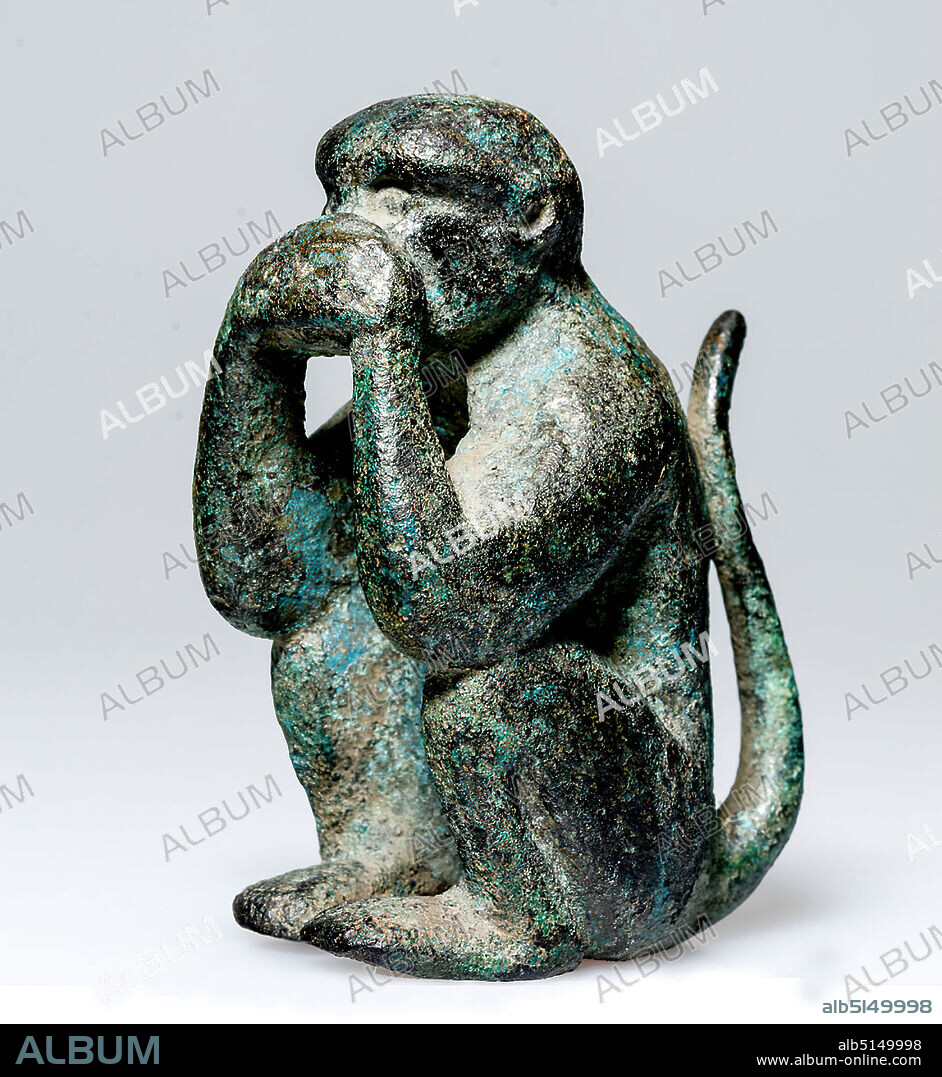alb5149998
Crouching monkey, Bronze, cast, bronze, full cast, Total: Height: 5 cm; Width: 2.2 cm; Depth: 3.2 cm, small sculptures, Monkeys, animals, pets, Late Classicism (Greek antiquity), The small monkey, probably a guenon, squats on its buttocks with its knees drawn up. The feet are set slightly inward; the elbows are supported on the knees, the hands are placed on top of each other in front of mouth and nose. The long tail is slightly S-shaped curved and erect; it touches the thoracic spine. In the Hellenistic and Roman world, Africa was considered the home of the monkey. The plautinischen comedies indicate that monkeys were held already in the 3. century v. Chr. as popular trained pets and luxury animals. Meerkats were most known in Italy, in Egypt, they were regarded as sacred animals after the Roman satitriker Iuvenal. Far more frequently than pets and lap-animals, monkeys occur as performers. Aelian reports that in Ptolemaic Egypt, monkeys were taught to distinguish letters, to blow the flute and to beat the harp, but also to ask for payment for these performances and, like professional beggars, to make the gifts disappear in bags.

|
Añadir a otro lightbox |
|
Añadir a otro lightbox |



¿Ya tienes cuenta? Iniciar sesión
¿No tienes cuenta? Regístrate
Compra esta imagen

Descripción:
Ver traducción automática
Crouching monkey, Bronze, cast, bronze, full cast, Total: Height: 5 cm; Width: 2.2 cm; Depth: 3.2 cm, small sculptures, Monkeys, animals, pets, Late Classicism (Greek antiquity), The small monkey, probably a guenon, squats on its buttocks with its knees drawn up. The feet are set slightly inward; the elbows are supported on the knees, the hands are placed on top of each other in front of mouth and nose. The long tail is slightly S-shaped curved and erect; it touches the thoracic spine. In the Hellenistic and Roman world, Africa was considered the home of the monkey. The plautinischen comedies indicate that monkeys were held already in the 3. century v. Chr. as popular trained pets and luxury animals. Meerkats were most known in Italy, in Egypt, they were regarded as sacred animals after the Roman satitriker Iuvenal. Far more frequently than pets and lap-animals, monkeys occur as performers. Aelian reports that in Ptolemaic Egypt, monkeys were taught to distinguish letters, to blow the flute and to beat the harp, but also to ask for payment for these performances and, like professional beggars, to make the gifts disappear in bags.
Crédito:
Album / quintlox
Autorizaciones:
Modelo: No - Propiedad: No
¿Preguntas relacionadas con los derechos?
¿Preguntas relacionadas con los derechos?
Tamaño imagen:
3974 x 4320 px | 49.1 MB
Tamaño impresión:
33.6 x 36.6 cm | 13.2 x 14.4 in (300 dpi)
Palabras clave:
AFRICA • AHORA • ANIMAL • ARPA • BOCA • BRONCE • BRONZE • CASA • CODOS • CON FRECUENCIA • CONSIDERA • ENSEÑÓ • FLAUTA • FRONTAL • HELENISTICA • HOGAR • INTERPRÈTES • ITALIA • MACACO • MANO • MANOS • MONO • MUNDO ROMANO • NARIZ • OBRA DE BRONCE • OKUPAS • PAGO • PIES • PROFUNDIDAD • PUESTO • REPARTO • RODILLAS • TOCA
 Pinterest
Pinterest Twitter
Twitter Facebook
Facebook Copiar enlace
Copiar enlace Email
Email
